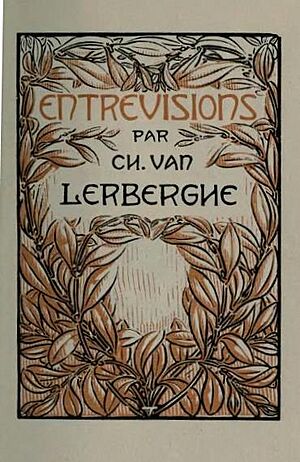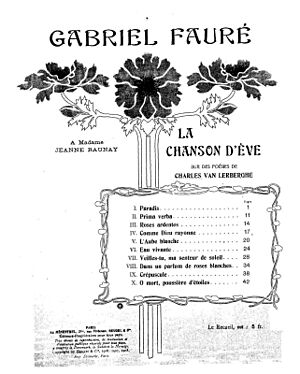Charles van Lerberghe facts for kids
Charles van Lerberghe (born October 21, 1861 – died October 26, 1907) was a Belgian writer. He wrote in French. He was known for his connection to the Symbolist movement. His later works often challenged old ideas. This made them popular with people who wanted new ways of thinking in the early 1900s.
Contents
Life of Charles van Lerberghe
Charles van Lerberghe was born in Ghent. His father was Flemish and his mother was Walloon. They were a comfortable family. Charles's father died when he was seven. His mother died when he was ten. He then lived with an uncle of Maurice Maeterlinck.
He went to a Jesuit school called Collège Ste-Barbe in Ghent. His friends Maurice Maeterlinck and Grégoire le Roy also went there. They all became poets. Later, Charles studied in Brussels. He earned his D.Phil. degree in 1894.
He also worked with his friends on magazines. These magazines supported a new style of writing in Belgium. A writer named Georges Rodenbach wrote about him in 1886. This was before Charles's first poetry book came out.
After his first poetry book, Entrevisions, was published in 1898, Charles traveled. He visited London, Berlin, Munich, and Rome. When he came back, he lived in Bouillon in the Ardennes region. There, he planned his big work, La Chanson d'Ève, which came out in 1904.
Two years later, he finished his funny play Pan. He was also writing new poems. Then he had a stroke. He later died from its effects in 1907. He was buried in the Evere cemetery in Brussels.
Works of Charles van Lerberghe
Van Lerberghe wrote poetry, plays, and short stories.
Short Stories
His short stories were mostly imaginative and dream-like. They appeared in different magazines from 1889 to 1906. Some were printed again after he died in 1931. They were called Contes hors du temps (Tales outside time). Eleven of them were republished in 1992.
He called them "symbolo-humoristico-philosophical stories." He felt they came from the Flemish side of his imagination. They also showed an "English" love for strange and unexpected things.
Plays
His first play was also very imaginative. It helped create a new type of play called 'the theatre of anguish'. This style showed feelings of worry and fear. Maurice Maeterlinck became a main writer of this style in Belgium.
The play was called Les Flaireurs (The Trackers). It was about an old woman dying in a lonely cottage. Only a child was with her on a stormy night. Unknown things were trying to get in. This play was very similar to Maeterlinck's play L’Intruse. Both plays were printed in 1890. Van Lerberghe's play was first performed in Brussels in 1892. It was also performed in Paris, the Netherlands, and Germany. It was translated into English as "The Night-comers" and "The Vultures."
One of his early poems was also like a play. It was a long poem called "Solayne." It had stage directions like: "While She speaks, the sky gradually dims and clouds resembling dark storm-tossed vessels pass over - and flights of owls." Parts of it appeared in magazines in 1887 and 1890. A writer named Robert Goffin put the poem together from van Lerberghe's notes. He published it in 1939 as Solyane, un chef d’oeuvre oublié (a forgotten masterpiece). The poem was about a female angel who fell from grace. This happened because she chose her feelings over other things.
Poetry Collections
Van Lerberghe gathered his poems into a book in 1898. He had been publishing them in magazines like La Wallonie and La Jeune Belgique. He called the collection Entrevisions (Glimpses). This title was a new word he created.
Some British writers saw similar ideas in his work. William Sharp thought it was like the work of Rossetti and Poe. His translator, Jethro Bithell, believed his images were inspired by Rossetti and Burne-Jones. These artists were inspired by early Italian painters like Sandro Botticelli. For example, the long, golden hair in Botticelli's paintings can be seen in van Lerberghe's poems:
Round are my mouth, my bosom, and
By grape or goblet may be spanned.
I have crowned with roses round
My hair, long, golden and unbound.
The poems in Entrevisions are simple in their form and language. They focus on imagination. Fernand Séverin said that the collection was "one of the foremost examples of Symbolist poetry." This means it used hints and suggestions to create meaning.
Van Lerberghe's next collection was Chanson d'Ève (Eve's Song), published in 1904. The poems in this book were similar in style. They were "subjective and impressionistic." This means they showed the poet's feelings and quick impressions. The book has a "Prelude" and four sections. These sections follow Eve from her innocent start in the Garden of Eden. They show her growing into human awareness. Van Lerberghe wrote about Eve's journey with understanding. He had different views on traditional religious ideas. In the end, Eve's song becomes quiet as she returns to the universe.
Satirical Comedy
Van Lerberghe's play Pan was a funny, three-act comedy. It was published in 1906. The play celebrated the main character's joyful, nature-focused beliefs. It was performed in Paris and Brussels in 1906. It also became popular in Eastern Europe. The play was liked by people who wanted to challenge old ways of thinking after World War I. Its performances in Latvia even caused some debate.
Music Inspired by His Poetry
Towards the end of van Lerberghe's life, the composer Gabriel Fauré found his poems very inspiring. Fauré felt the poems had a beautiful, graceful language. This led him to create two important song cycles. From 1906 to 1909, Fauré set ten poems from La chanson d'Ève to music. He then created another cycle, Le jardin clos, in 1914. Fauré chose poems that highlighted the book's ideas about challenging traditional beliefs.
Other composers also created song cycles from van Lerberghe's poems. Paul Lacombe chose six poems from Chanson d’Éve in 1907. Robert Herberigs chose eleven in 1922. Alfred La Liberté chose fifteen in 1925. René Bernier set four poems from Entrevisions in 1925. Some single poems were also set to music. These included "Berceuse" by Alphons Diepenbrock in 1912. "Barque d'Or" was set by Aldo Finzi in the 1920s. Eva Ruth Spalding also set "Vers le Soleil" in 1923.
Legacy
In 1911, a stone plaque was placed on the house where Charles van Lerberghe was born. This was four years after he died. The plaque has Art Nouveau letters. The house is now at 83 Franklin Rooseveltlaan.
In 1936, a group of writers put up a carved stone in Bouillon. It says that van Lerberghe wrote La Chanson d'Ève in that town. A small square by the river in Bouillon is also named Square Van Lerberghe. In Brussels, a street in the Schaerbeek area is named fr:Rue Charles Van Lerberghe.
See also
 In Spanish: Charles Van Lerberghe para niños
In Spanish: Charles Van Lerberghe para niños




